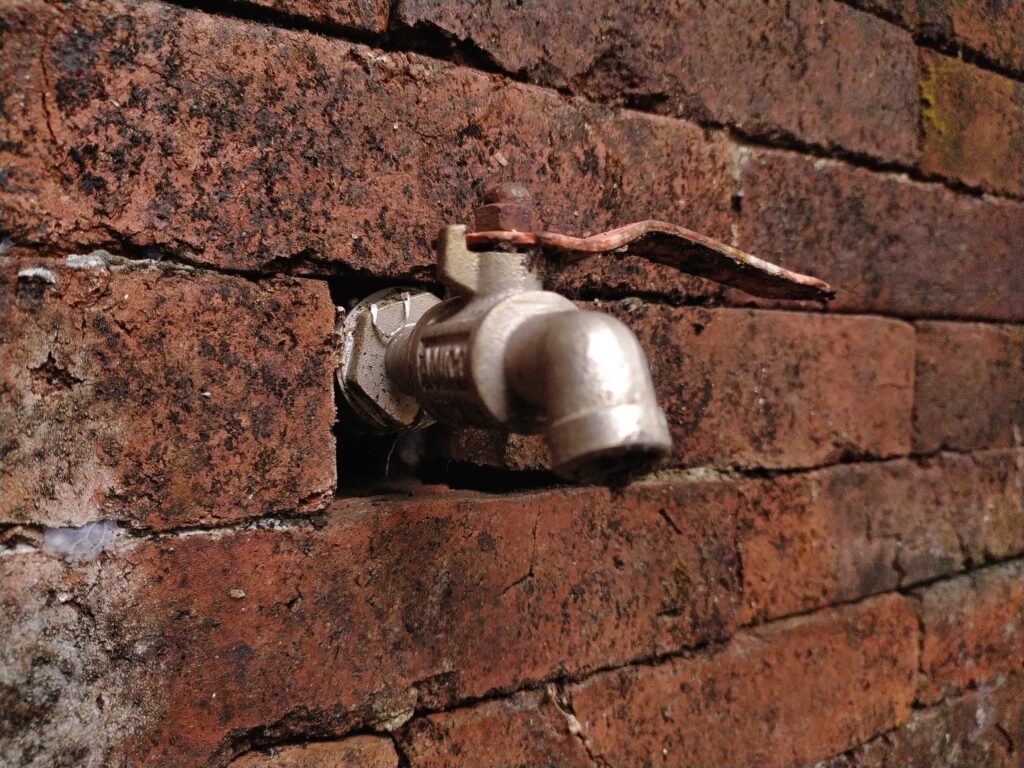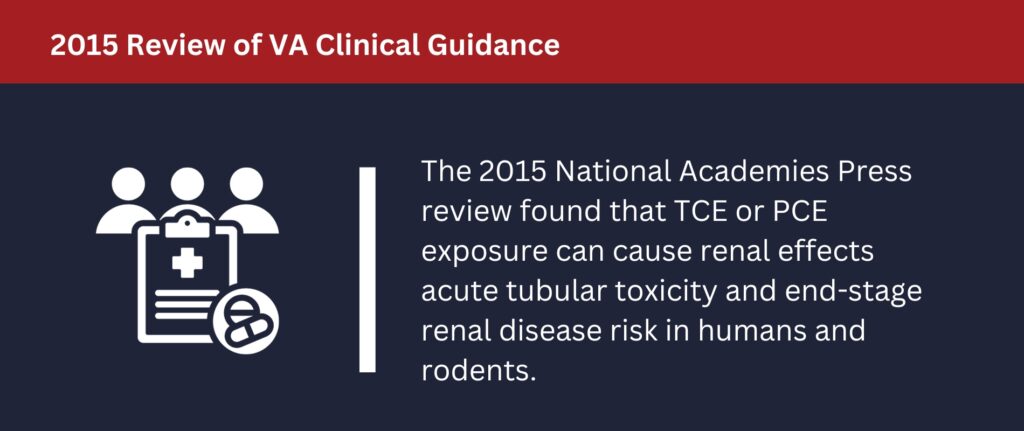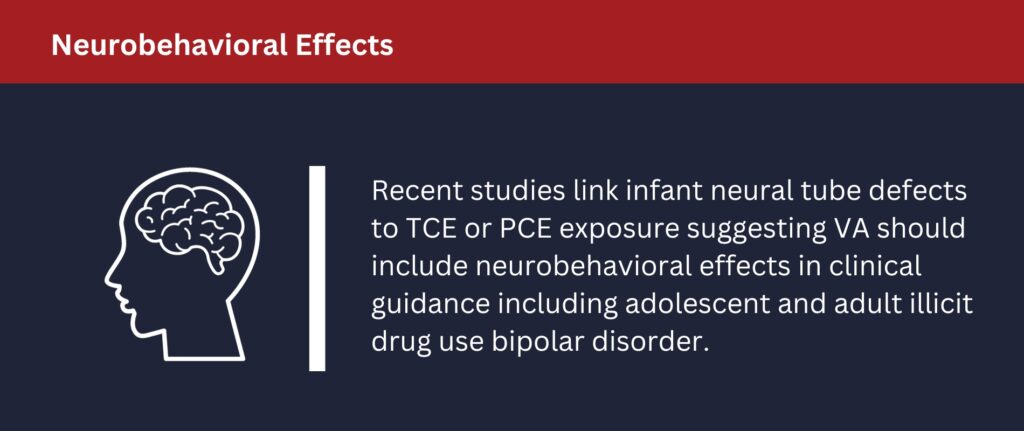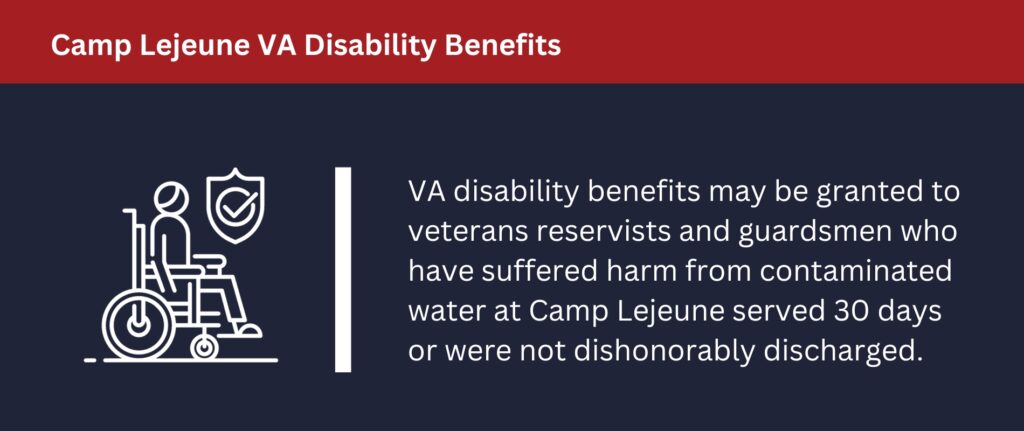|
Nadrich Accident Injury Lawyers is no longer actively retaining Camp Lejeune claimants. |
|---|

The water at Camp Lejeune in North Carolina was contaminated by volatile organic compounds (VOCs) from 1953 to 1987. The chemicals the water was contaminated with include trichloroethylene (TCE) and perchloroethylene (PCE). Those who were exposed to it may be eligible for financial compensation, thanks to a new bill that is expected to be signed into law by President Biden soon.
The bill will allow those who were exposed to the contaminated water to take legal action in order to obtain appropriate financial compensation for any harm that was caused by being exposed to the contaminated water at the North Carolina Marine Corps camp.
There are a number of health effects that have been linked to the contaminated water at Camp Lejeune. These health effects have been documented by a 2009 National Research Council (NRC) report, clinical guidance reports published by a committee of experts established by the Veteran’s Administration (VA), and studies by the Agency for Toxic Substances and Disease Registry (ATSDR).
2009 National Research Council Report
In 2009, the National Research Council published Contaminated Water Supplies at Camp Lejeune: Assessing Potential Health Effects. The report was prepared by a committee at the request of the Navy, which consisted of experts in toxicology, epidemiology, environmental health, exposure analysis, risk assessment, biostatistics, and groundwater modeling.
The report focused on what scientific evidence says about any causal relationship between health outcomes and past exposure to the contaminated water at Camp Lejeune. It found that not only was drinking the water considered exposure to the contaminants, but bathing, showering, and washing dishes could also expose people to the contaminants since TCE and PCE in hot water can evaporate and be inhaled.
Contaminated Water Sources

According to the report, two water systems at Camp Lejeune had been contaminated: the Tarawa Terrace system and the Hadnot Point system.
The primary contaminant in the Tarawa Terrace system’s water was PCE, a dry-cleaning solvent that was used by ABC One-Hour Cleaners, an off-base dry cleaning facility. The contamination occurred due to spills, as well as improper disposal.
The water in the Hadnot Point system was contaminated with TCE, trans-1,2-DCE, PCE, methylene chloride, and vinyl chloride. There were multiple sources of contamination in the Hadnot Point system, according to the report, including:
- A drum dump
- An industrial area
- An industrial fly ash dump
- A transformer storage lot
- A former fire training area
- An open storage pit
- A liquids disposal area
- A former on-base dry cleaning site
- A fuel-tank sludge area
- A former burn dump
- An original base dump site
Reported Health Effects
When reviewing epidemiologic evidence, the report found limited or suggested evidence of an association between exposure to TCE, PCE, or solvent mixtures and numerous health effects, meaning evidence existed that those exposed to these substances are more likely to suffer from the health effects. However, the studies had limitations or were few in number. Those health effects were:
- Lung cancer
- Esophageal cancer
- Bladder cancer
- Breast cancer
- Adult leukemia
- Kidney cancer
- Myelodysplastic syndromes
- Multiple myeloma
- Hepatic steatosis
- Renal toxicity
- Miscarriage
- Female infertility
- Neurobehavioral effects
- Scleroderma
The report also found that while inadequate or insufficient evidence exists to determine if there’s an association between exposure to TCE, PCE, or solvent mixtures and numerous other health effects, an association also can’t be ruled out. Those health effects were:
- Nasal cancer
- Oral/pharyngeal cancer
- Esophageal cancer
- Laryngeal cancer
- Colon cancer
- Stomach cancer
- Pancreatic cancer
- Rectal cancer
- Lung cancer
- Hepatobiliary cancer
- Soft tissue sarcoma
- Bone cancer
- Non-melanoma skin cancer
- Melanoma
- Cervical cancer
- Breast cancer
- Bladder cancer
- Prostate cancer
- Non-Hodgkin lymphoma
- Cancer of the central nervous system or brain
- Multiple myeloma
- Hodgkin disease
- Myelodysplastic syndromes
- Adult leukemia
- Childhood neuroblastoma
- Childhood leukemia
- Aplastic anemia
- Childhood brain cancer
- Male infertility
- Congenital malformations
- Miscarriage
- Fetal growth restriction
- Preterm birth
- Female infertility
- Cardiovascular effects
- Gastrointestinal effects
- Liver function issues
- Risk of cirrhosis
- Amyotrophic lateral sclerosis
- Renal toxicity
- Multiple sclerosis
- Parkinson’s disease
- Long-term color discrimination reduction
- Alzheimer’s disease
- Long-term olfactory function reduction
- Long-term loss of hearing
Toxicologic Evidence Findings
When reviewing toxicologic evidence, the report found that TCE or PCE could cause the following in rats or mice:
- Kidney cancer
- Testicular cancer
- Liver cancer
- Lung cancer
- Mononuclear cell leukemia
The report concluded that kidney cancer was the most relevant of these health effects on humans. Other health effects the report identified that were linked by toxicologic evidence to TCE or PCE included:
- Kidney toxicity
- Liver toxicity
- Effects on male fertility
- Adverse effects on offspring
- Adverse changes in nervous system measurements
- Immune system effects
When considering the toxicologic and epidemiologic evidence together, the report concluded that there was suggestive/limited evidence for an association between TCE or PCE exposure and:
- Kidney cancer
- Esophageal cancer
- Lung cancer
- Breast cancer
- Bladder cancer
The report found that the toxicological evidence most strongly supported a link with kidney cancer. It also found that effects of TCE and PCE that were similar in humans and lab animals included adverse effects on the immune system, nervous system, kidneys, and liver.
The report found that the following health effects were seen in both epidemiologic and toxicologic studies:
- Kidney cancer
- Kidney toxicity
- Liver toxicity
- Immunologic effects
- Neurobehavioral effects
2015 Review of VA Clinical Guidance


A Review of VA Clinical Guidance for the Health Conditions Identified by the Camp Lejeune Legislation was published in 2015 by the National Academies Press. It was compiled by a committee of experts established by the VA.
The review found that exposure to TCE or PCE can cause renal effects such as tubular necrosis, cytomegaly, tubular epithelium necrosis, and karyomegaly.
It also found that strong evidence exists suggesting an association between TCE or PCE exposure and acute tubular toxicity in humans and rodents. The review also found that evidence exists for a link between PCE or TCE exposure and the risk of death from end-stage renal disease.
Parkinson’s Disease
The review found that while the 2009 NRC report determined that there was inadequate or insufficient evidence to establish a link between TCE or PCE exposure and Parkinson’s disease, newer studies that the VA-established committee assessed led the committee to conclude that TCE or PCE exposure may cause Parkinson’s disease.
Neurobehavioral Effects

The review found that recent studies established a “clear association” between infant neural tube defects and mothers being exposed to TCE or PCE. It suggests that the VA should consider stating in its clinical guidance that these neural tube defects can cause neurobehavioral effects.
The review also recommended that the VA consider stating that adolescent illicit drug use and adult illicit drug use, as well as bipolar disorder, be mentioned in its clinical guidance as neurobehavioral effects related to TCE or PCE exposure.
Vision Impairment
The review found that there is an association between TCE or PCE exposure and deficits in color discrimination and contrast sensitivity regarding vision.
Cancer
The review concluded that the VA should cover eight different cancers (esophageal, lung, breast, bladder, kidney, leukemia, non-Hodgkin lymphoma, and multiple myeloma) in its Camp Lejeune program regardless of latency.
Scleroderma
While the 2009 NRC report found only limited or suggestive evidence suggesting an association between scleroderma and exposure to mixed solvents, the review concluded that new evidence confirmed an association between TCE and scleroderma.
Other Health Effects
The review found that exposure to TCE or PCE may result in infertility or miscarriage. It also found that exposure to TCE or PCE is associated with hepatic steatosis, also known as fatty liver.
ATSDR Studies
ATSDR studies have linked numerous health effects to the contaminated water exposure at Camp Lejeune. These studies have linked the following health effects with exposure to Camp Lejeune’s contaminated water:
- Male breast cancer
- Kidney cancer
- Leukemia
- Rectal cancer
- Prostate cancer
- Parkinson’s disease
- Cervical cancer
- Esophageal cancer
- Liver cancer
- Hodgkin lymphoma
- Multiple myeloma
- Bladder cancer
- Kidney disease
- Preterm birth
- Small for gestational age infants
- Term low birth weight
- Reduced mean birth weight
- Neural tube defects
- Child hematopoietic cancers like leukemia
Camp Lejeune VA Disability Benefits

Those who have suffered harm due to the contaminated water at Camp Lejeune may qualify for disability benefits from VA. In order to qualify, both of the following must apply to you:
- You served at Camp Lejeune, or you served at MCAS New River, for 30 cumulative days or more from August 1953 through December 1987
- You were not dishonorably discharged
When both of the above are true, veterans, reservists, and guardsmen will qualify for disability benefits if they have been diagnosed with one or more of the following:
- Aplastic anemia
- A myelodysplastic syndrome
- Adult leukemia
- Kidney cancer
- Bladder cancer
- Multiple myeloma
- Liver cancer
- Parkinson’s disease
- Non-Hodgkin lymphoma
Camp Lejeune Healthcare Benefits
You may qualify for healthcare benefits from the VA if you have suffered harm due to the water at Camp Lejeune. The VA will compensate you for any out-of-pocket medical costs related to:
- Breast cancer
- Bladder cancer
- Female infertility
- Esophageal cancer
- Kidney cancer
- Hepatic steatosis
- Lung cancer
- Leukemia
- Multiple myeloma
- Miscarriage
- Neurobehavioral effects
- Myelodysplastic syndromes
- Renal toxicity
- Non-Hodgkin lymphoma
- Scleroderma
Camp Lejeune Justice Act of 2022

The Camp Lejeune Justice Act of 2022 is expected to be signed into law soon by President Biden. It will allow those who have been harmed by the contaminated water at the military base to obtain financial compensation for their injuries in legal proceedings.
The bill will apply to anyone, military or civilian, who lived, worked, or was otherwise exposed to the contaminated water at Camp Lejeune from August 1, 1953, to December 31, 1987.
In order to obtain financial compensation, claimants will need to be able to provide evidence that is:
- Enough to establish a causal relationship between their injuries and exposure to Camp Lejeune’s contaminated water; or
- Enough to establish that it is at least as likely that a causal relationship between exposure to the water and their injuries exists as it is a causal relationship not existing.
Claims under the act may not be filed once either condition expires:
- Two years after the act is enacted; or
- 180 days after the claim is denied by 28 U.S. Code § 2675.
Nadrich Accident Injury Lawyers can help gather evidence for you and make sure that you are able to file a successful claim for financial compensation for your Camp Lejeune injuries on time.
About Nadrich Accident Injury Lawyers
Nadrich Accident Injury Lawyers are Camp Lejeune water contamination lawyers with over 30 years of experience representing hazardous exposure clients. We have recovered over $750,000,000 on behalf of our clients, including clients who have been exposed to dangerous chemicals such as paraquat, Roundup, AFFF firefighting foam, and benzene.
We have extensive experience in proving that our clients’ injuries were caused by exposure to dangerous chemicals, and we have a long track record of success in obtaining financial compensation for our clients’:
- Medical bills
- Lost wages
- Lost earning capacity
- Emotional distress
- Pain and suffering
- Loss of enjoyment of life
- Loss of companionship
The only fee we charge is 25 percent of any financial compensation we help our clients recover. We do not charge a fee if we don’t obtain a recovery, meaning you won’t be charged a penny if we don’t win your case.
Contact Our Camp Lejeune Water Contamination Lawyers
If you or a loved one has been harmed by the contaminated water at Camp Lejeune, the experienced hazardous exposure lawyers at Nadrich Accident Injury Lawyers can help you obtain financial compensation for your injuries.
Contact us today for a free consultation if you or a loved one was harmed due to being exposed to contaminated water at Camp Lejeune. You may be eligible for financial recovery. We won’t charge a fee unless we obtain compensation for you.

